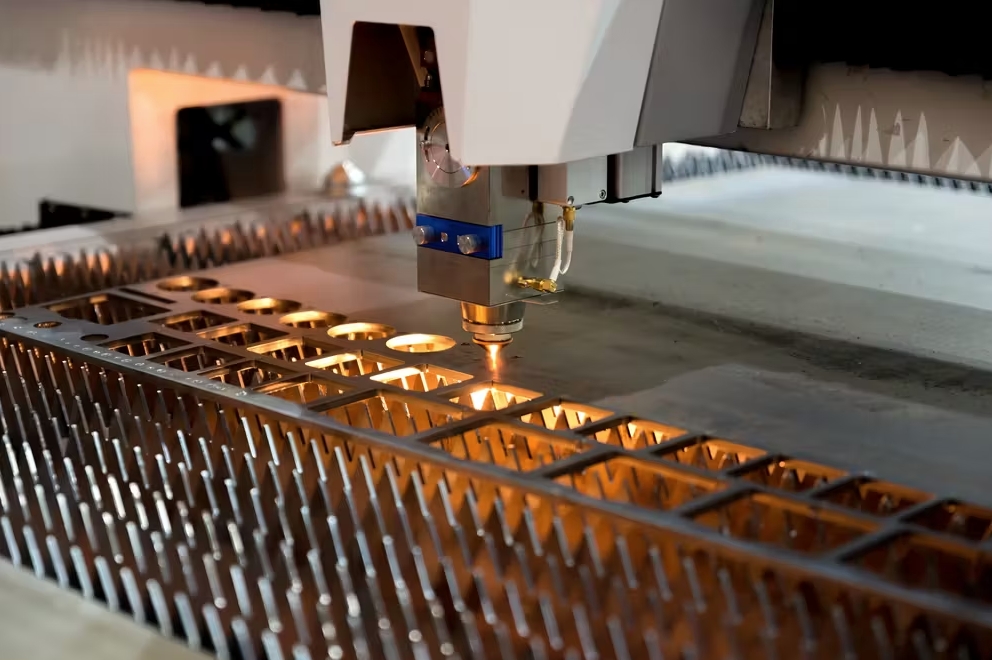Laser cutting is a popular technology used in a range of different industries. It is used to cheaply and quickly produce flat, precisely cut components. The most common laser cutters are based on CO2 or fiber lasers. However, newer technologies, such as direct diode laser cutting, are gaining popularity. Industrial laser cutters are often used to cut metals, plastics, and even ceramics. Figure 1 below is an example of a laser cutting machine:
This article will describe how ten major industries make use of laser cutters, as well as review the characteristics of the major types of laser cutters and the main cutting techniques.

What Are the Industries that Use Laser Cutting?
Industrial laser cutters are used in most modern industries because they offer a low-cost, high-speed method for making high-precision cuts. Listed below are some common industries which use laser cutters:
What Is Laser Cutting?
Laser cutting is a process that can make accurate, complex cuts completely through the thickness of such materials as metal, plastic, and wood. It does this by focusing a beam of light energy into a small point on the surface of the material to be cut, melting/vaporizing it, and blowing it from the cut path with the assistance of a gas jet. Metal cutting requires higher laser power than cutting plastics and wood. The most common industrial lasers employ fiber and CO2 lasers,although there are a number of laser-cutting technologies.
What Are the Types of Laser Cutting Used in Industry?
Four general types of laser cutters are used in industrial applications, as listed below:
CO2 Laser: CO2 lasers are relatively old technology but are still widely used for metal cutting in the automotive, and manufacturing industries. These lasers also do well with organic materials like wood and fabric. CO2 lasers require regular maintenance, as their laser tubes tend to fail over time.
Fiber Lasers: Fiber lasers are well suited to metal cutting, and can produce precise cuts in a variety of materials. Fiber lasers have higher energy densities than CO2 lasers and are preferred over CO2 lasers in the automotive, manufacturing, and aerospace industries.
Nd:YAG & Nd:YVO Lasers: These crystal-based lasers have higher power densities than fiber lasers and are widely used for marking and etching as well as for use in the medical industry for various eye treatments. These lasers, however, have high operating costs and low efficiencies.
Direct Diode Lasers: Direct diode lasers are far simpler than the other technologies in this list, and recent advances have achieved power densities high enough for cutting metals. Direct diode lasers are also able to cut at higher speeds than fiber lasers. Due to the high precision, superior cut edge, and improved efficiencies, direct diode lasers are used for cutting superalloys like Inconel® and Hastelloy® which are typically used in the aerospace and energy industries.
What Are the Things You Can Do With Laser Cutting?
Apart from simply cutting materials, lasers can be used for a range of other techniques as listed below:
Perforating: Laser perforation is a process whereby a small hole, roughly the diameter of the beam, is made through the material. These holes are often very close to each other. An example of perforation would be the creation of tear lines in vehicle interior trim components so that they separate as intended when an airbag is deployed.
Seaming: Seaming is a type of welding used to bond two thin materials to each other. It is often used on fabrics, as well as for welding thin metal components like those found in battery housings.
Etching: Laser etching melts a thin surface layer of material in a prescribed pattern. It removes no more than 0.0001 inches of material and leaves a high-contrast image. Etching is often used to permanently mark components for traceability.
Engraving: Laser engraving ablates surface material away to produce a 3D design. Two common techniques include concave and convex engraving.
Marking: Laser marking is used to discolor the surface of a material by using a low-power laser beam. Unlike laser etching, laser marking does not remove any material from the surface. For some metals, the surface is annealed, which causes a color change.
Drilling: Laser drilling is an alternative to mechanical drilling using a rotating drill bit. It is often used to cut very small, high aspect ratio holes of as small as 0.002 microns. These holes can be made to be extremely precise.
How Does Laser Cutting Work?
Laser cutting works by directing a high-powered beam of light into a sheet of material to produce a 2-dimensional profile. In the case of common lasers like CO2 and fiber lasers, the beam is generated inside a resonator that amplifies the light energy until it reaches the desired energy level. The beam is directed using mirrors (CO2) or along a fiber optic cable (fiber laser) down to the material surface. The laser melts, burns, or removes the material in order to cut through it.
Is There an Industry That Offers Laser Cutting Services?
Yes, the contract manufacturing industry offers various laser-cutting services. Outsourcing laser cutting is an excellent way to save money as the initial capital investment for a laser cutter is significant.
Proto MFG provides a wide range of manufacturing capabilities, including sheet metal fabrication and other value-added services for all of your prototyping and production needs. Visit our website to learn more or to request a free, no-obligation quote.